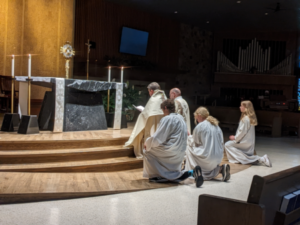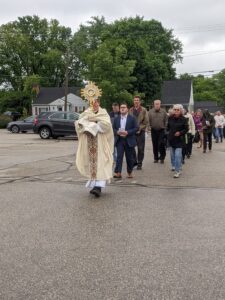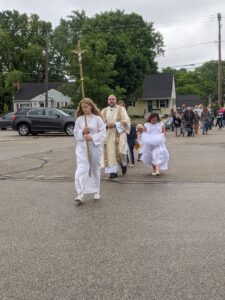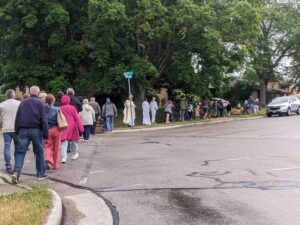Because Faith Matters
The Solemnity of the Most Holy Body and Blood of Christ is also known as the Solemnity of Corpus Christi, which translates from Latin to “Body of Christ.” This feast originated in France in the midthirteenth century and was extended to the whole Church by Pope Urban IV in 1264. This feast is celebrated on the Thursday following the Trinity Sunday; 60 days after Easter, or the Sunday immediately following this (Holy Trinity Sunday is celebrated on the first Sunday following Pentecost in most of the liturgical churches in Western Christianity. It is a solemn celebration of the belief in the revelation of one God, yet three divine persons) or, as in the USA, on the Sunday following that feast.
2023 Feast of Corpus Christi
The Story Behind the Feast of Corpus Christi
The Solemnity of the Most Holy Body and Blood of Christ, historically known by its Latin name, Corpus Christi, celebrates the Real Presence of Jesus Christ in the Holy Eucharist—Body, Blood, Soul, and Divinity. It is traditionally celebrated on the Thursday following the Solemnity of the Holy Trinity. The feast dates to the Middle Ages and originated with a visionary nun and a Eucharistic miracle.
In 1263 a German priest, Fr. Peter of Prague, made a pilgrimage to Rome. He stopped in Bolsena, Italy, to celebrate Mass at the Church of St. Christina. At the time he was having doubts about Jesus being truly present in the Blessed Sacrament. He was affected by the growing debate among certain theologians who, for the first time in the history of the Church, began introducing doubts about the Body and Blood of Christ being actually present in the consecrated bread and wine. In response to his doubt, when he recited the prayer of consecration as he celebrated the Holy Sacrifice of the Mass, blood started seeping from the consecrated host and onto the altar and corporal.
Fr. Peter reported this miracle to Pope Urban IV, who at the time was nearby in Orvieto. The pope sent delegates to investigate and ordered that host and blood-stained corporal be brought to Orvieto. The relics were then placed in the Cathedral of Orvieto, where they remain today (see photo below).
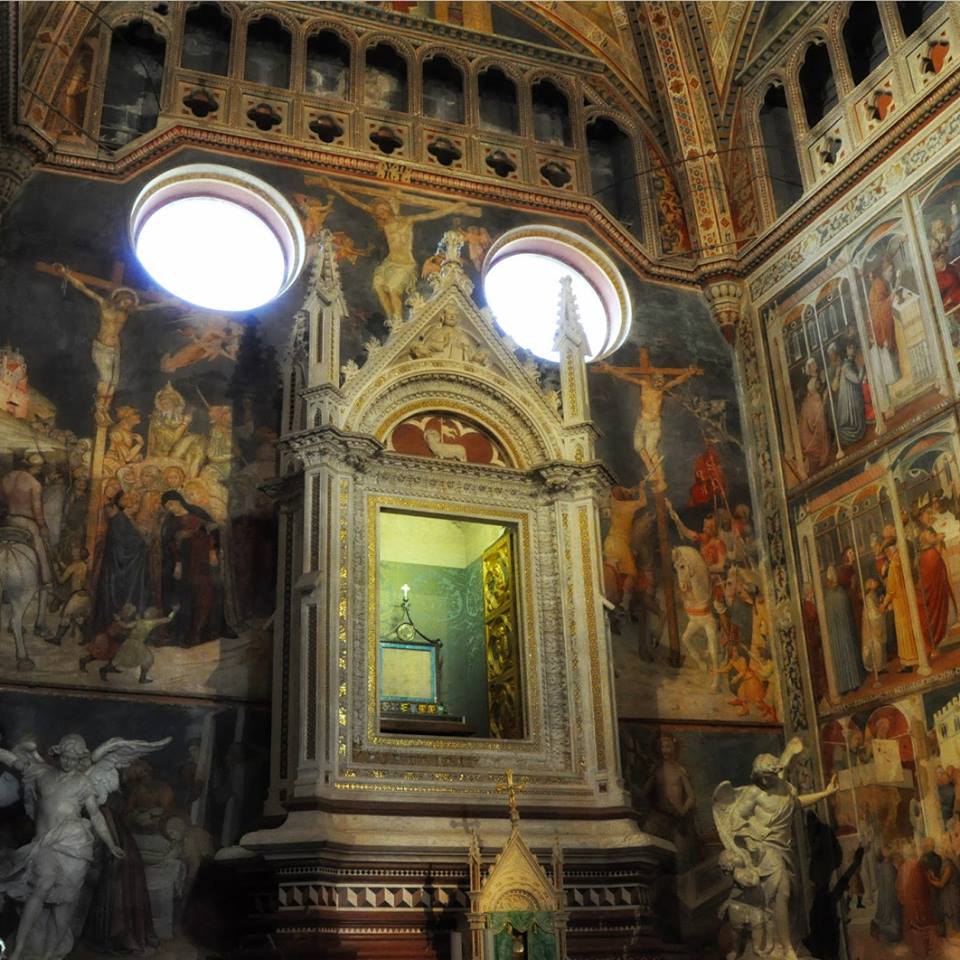
This Eucharistic Miracle confirmed the visions given to St. Juliana of Mont Cornillon in Belgium (1193-1258). St. Juliana was a nun and mystic who had a series of visions in which she was instructed by Our Lord to work to establish a liturgical feast for the Holy Eucharist, to which she had a great devotion.
After many years of trying, she finally convinced the bishop, the future Pope Urban IV, to create this special feast in honor of the Blessed Sacrament, where none had existed before. Soon after her death, Pope Urban instituted Corpus Christi for the Universal Church and celebrated it for the first time in Orvieto in 1264, a year after the Eucharistic Miracle in Bolsena (read Eucharistic Miracle in Poland Tested and Confirmed by Bishop below).
Inspired by the miracle, Pope Urban commissioned a Dominican friar, St. Thomas Aquinas, to compose the Mass and Office for the feast of Corpus Christi. Aquinas’ hymns in honor of the Holy Eucharist, Pange Lingua, Tantum Ergo, Panis Angelicus, and O Salutaris Hostia are the beloved hymns the Church sings on the feast of Corpus Christi as well as throughout the year during Exposition and Benediction of the Blessed Sacrament.
The Origins of the Feast of Corpus Christi
Most Holy Body and Blood of Jesus Christ
FEAST OF CORPUS CHRISTI | Tracing Its Origins
Eucharistic Miracle in Poland Tested & Confirmed by Bishop
Apr 22, 2016 by Gretchen Filz
Once again, Our Lord has granted the Church a Eucharistic Miracle to strengthen our faltering faith in, and proper reverence toward, this central teaching of the Catholic faith: When Jesus said, “This is my body,” and, “This is my blood,” he meant it literally.
So they said to him, “What sign are you going to give us then, so that we may see it and believe you? What work are you performing?
Jesus answered them . . . I am the living bread that came down from heaven. Whoever eats of this bread will live forever; and the bread that I will give for the life of the world is my flesh . . .
The Jews then disputed among themselves, saying, “How can this man give us his flesh to eat?” So Jesus said to them, “Very truly, I tell you, unless you eat the flesh of the Son of Man and drink his blood, you have no life in you. Those who eat my flesh and drink my blood have eternal life, and I will raise them up on the last day; for my flesh is true food and my blood is true drink. Those who eat my flesh and drink my blood abide in me, and I in them. (John 6)
A Eucharistic Miracle is when God allows us to see with our own eyes the consecrated host as it truly is—the Body and Blood of Jesus Christ. But it is not unique. We experience a Eucharistic miracle at every Mass. Every Holy Communion that we receive into our bodies is the same miracle. We just can’t detect it with our senses, but by faith and effect we know it to be true. And it is a holy and fearful thing.
As reported by CNA/EWTN News that week:
A bleeding Host that “has the hallmarks of a Eucharistic miracle” was approved for veneration in Poland over the weekend.
The announcement was made by Bishop Zbigniew Kiernikowski of Legnica on April 17.
On Christmas Day 2013, a consecrated Host fell to the floor, the bishop said. It was picked up and placed in a container with water. Soon after, red stains appeared on the host.
Then-Bishop of Legnica, Stefan Cichy, created a commission to monitor the host. In February 2014, a small fragment was placed on a corporal and underwent testing by various research institutes.
The final medical statement by the Department of Forensic Medicine found:
“In the histopathological image, the fragments were found containing the fragmented parts of the cross striated muscle. It is most similar to the heart muscle.”
Tests also determined the tissue to be of human origin, and found that it bore signs of distress.
Saying that the Host “has the hallmarks of a Eucharistic miracle,” Bishop Kiernikowski explained that in January 2016 he presented the matter to the Vatican’s Congregation for the Doctrine of the Faith.
In April, in accordance with the Holy See’s recommendations, he asked parish priest Andrzej Ziombrze “to prepare a suitable place for the Relics so that the faithful could venerate it.
Pope Francis' Eucharistic Miracle in Argentina
Apr 01, 2013 by Gretchen Filz
 Easter is a beautiful time to deepen our devotion to Jesus in the Blessed Sacrament. The Pascal Mystery which we celebrate in a special way during the Easter Triduum—the Passion, death and bodily resurrection of Christ—is daily present to us in the Eucharist. The Church teaches that Jesus is really, truly, and actually there—Body, Blood, Soul, and Divinity—in the Holy Eucharist.
Easter is a beautiful time to deepen our devotion to Jesus in the Blessed Sacrament. The Pascal Mystery which we celebrate in a special way during the Easter Triduum—the Passion, death and bodily resurrection of Christ—is daily present to us in the Eucharist. The Church teaches that Jesus is really, truly, and actually there—Body, Blood, Soul, and Divinity—in the Holy Eucharist.
Unfortunately it is all to easy, due to human weakness, to begin to lose our sense of awe, wonder, and adoration of Our Lord in the Eucharist.
A great way to reinvigorate our belief and to encourage devotion to Our Lord in the Blessed Sacrament is by reading accounts of Eucharistic miracles that have occurred throughout the ages of the Church, from the earliest years to modern times. In fact, Jesus gives us these miracles throughout the centuries so that our love for him in the Eucharist will not wane or grow cold.
If you haven’t had the chance to visit a Eucharistic Miracle exhibit, we highly recommend it. You can read many of the accounts online at the Real Presence Eucharistic Education and Adoration Association website. Click on the “English” tab and scroll down until you see “Miracles by Country”. Each of those hyperlinks opens to a PDF document of various documented, Church-verified accounts of Eucharistic Miracles.
One recent account of a scientifically analyzed Eucharistic Miracle was witnessed by our own Pope Francis while he was Cardinal Bergoglio (see below).
Cardinal Bergoglio's Eucharistic Miracle: Buenos Aires, 1996
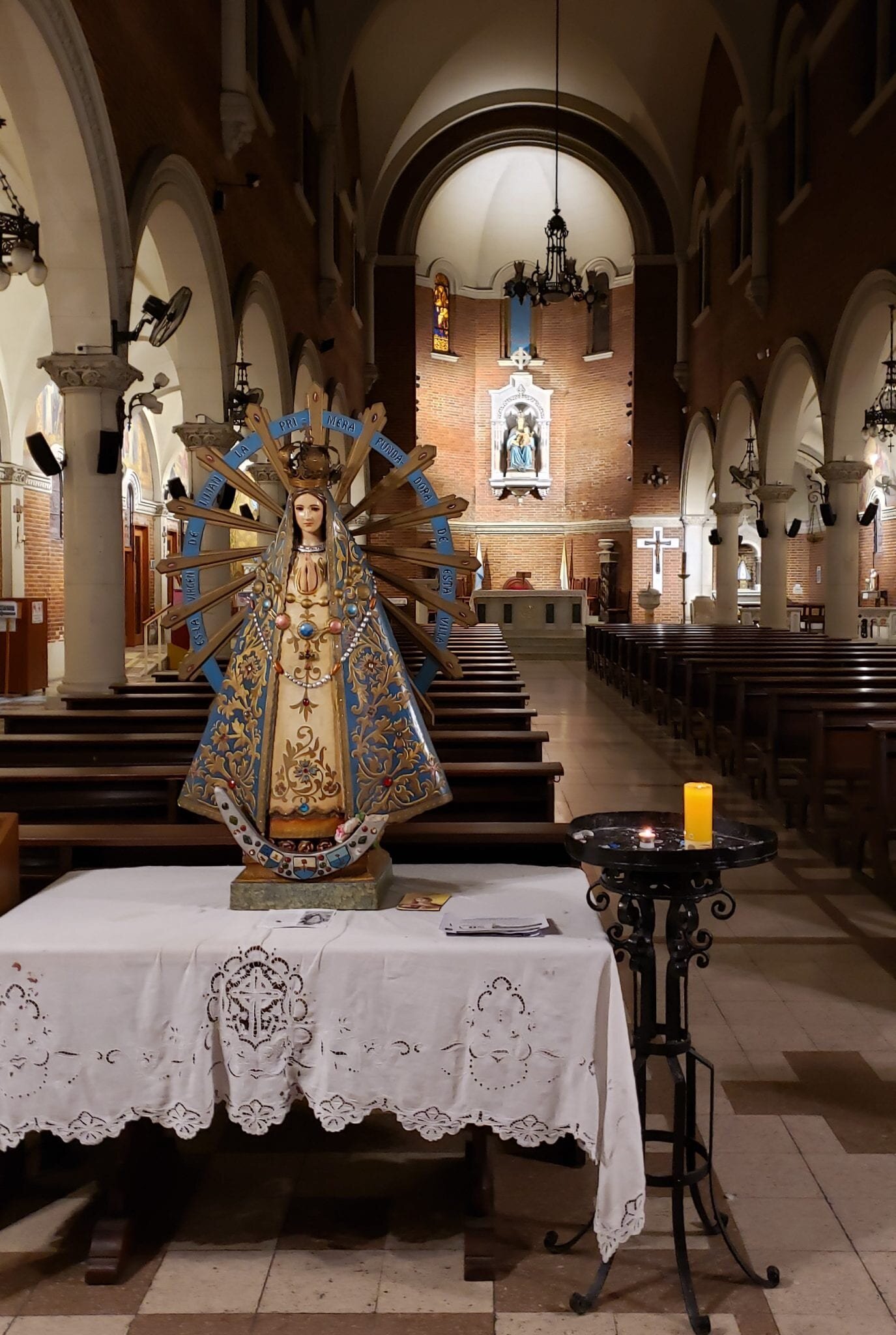
Fr. Alejandro Pezet, a priest of the Archdiocese of Buenos Aires, had finished distributing Communion and was cleaning up the church after Mass when he discovered a discarded host in the back of the church. Whether the individual who had received it during Mass wasn’t Catholic or had left it in the pews for another reason is uncertain, but Fr. Pezet carefully placed the host in a container full of water to allow it to dissolve. Two days later, as he was preparing to dispose of what was left of the host, he uncovered the container only to find that the host appeared to be covered with red blotches of blood.
Confused by what he found, and seeking guidance from the Church, Fr. Pezet reported the matter to the auxiliary bishop of Buenos Aires, Jorge Bergoglio. If this name sounds familiar, it’s because you know this man – he now goes by the name “Pope Francis!” Bishop Bergoglio, after examining the host, ordered that it be observed and photographed. Taken only a few weeks after the host was first discovered, the photographs showed that the host had grown in size, and now had the appearance of bloody flesh. After three years of observation, the host had not shown signs of decomposing, so Bishop Bergoglio asked that it be scientifically analyzed.
In 1999, Dr. Frederick Zugibe, a cardiologist and forensic pathologist, began performing tests on the miraculous host. What he discovered about the composition of the host is truly stunning:
-
The analyzed material appeared to be a fragment of heart muscle typically found in the wall of the left ventricle of the heart, close to the valves.
-
This type of muscle is responsible for the contraction of the heart, and the left ventricle connects nearly all the organ systems by pumping oxygenated blood to the rest of the body.
-
The blood found on the sample was indeed human, and type AB, which also matches the blood found on the host of Lanciano and from samples extracted from the Shroud of Turin, believed by many to be the burial cloth of Jesus.
-
The tissue appeared to be in an inflamed state, and contained a large number of white blood cells, indicating that the heart was alive at the time the sample was taken, since these white blood cells die outside of a living organism.
-
Furthermore, the white blood cells had penetrated the tissue, further indicating that the heart was under severe stress, as if the person themselves had been beaten severely near the chest area.
In an effort to keep the studies as objective as possible, Dr. Zugibe was not informed about the origin of the samples he had analyzed. But after completing the studies, he remarked, “You have to explain one thing to me: If this sample came from a dead person, how could it be that while I was examining it, the cells of the sample were moving and pulsating? If the heart came from someone who died in 1996, how could it still be alive?” When he was informed that the samples had been taken from the miraculous host, he stated, “This will remain an inexplicable mystery to science—a mystery totally beyond her competence.”
As we prepare to celebrate Corpus Christi, perhaps we can take a moment to remember how mysterious and powerful the doctrine of the Eucharist truly is!
